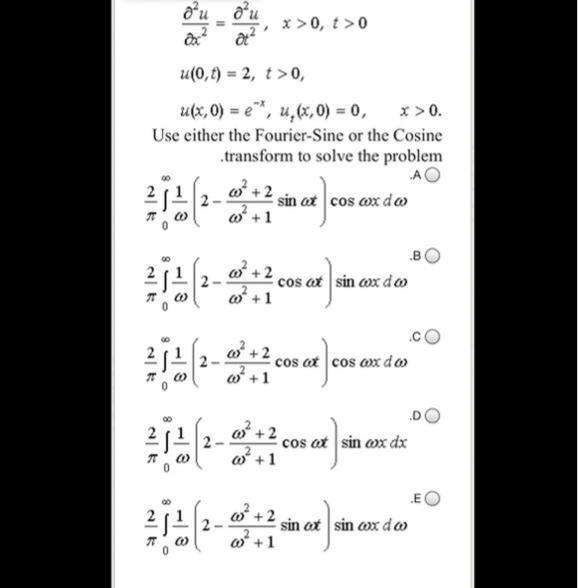Question
o'u o'u x >0, t >0 u(0,t) = 2, t>0, u(x,0) = e, u,x,0) = 0, x> 0. Use either the Fourier-Sine or the

o'u o'u x >0, t >0 u(0,t) = 2, t>0, u(x,0) = e, u,x,0) = 0, x> 0. Use either the Fourier-Sine or the Cosine .transform to solve the problem AO o +2 2 sin ot cos ax do of +1 .B o +2 cos at sin ox d o of +1 +2 cos at cos ax do o +1 cos at sin ox dx of +1 EO o +2 sin ot sin ax d a +1
Step by Step Solution
3.45 Rating (158 Votes )
There are 3 Steps involved in it
Step: 1

Get Instant Access to Expert-Tailored Solutions
See step-by-step solutions with expert insights and AI powered tools for academic success
Step: 2

Step: 3

Ace Your Homework with AI
Get the answers you need in no time with our AI-driven, step-by-step assistance
Get StartedRecommended Textbook for
Numerical Analysis
Authors: Richard L. Burden, J. Douglas Faires
9th edition
538733519, 978-1133169338, 1133169333, 978-0538733519
Students also viewed these Mathematics questions
Question
Answered: 1 week ago
Question
Answered: 1 week ago
Question
Answered: 1 week ago
Question
Answered: 1 week ago
Question
Answered: 1 week ago
Question
Answered: 1 week ago
Question
Answered: 1 week ago
Question
Answered: 1 week ago
Question
Answered: 1 week ago
Question
Answered: 1 week ago
Question
Answered: 1 week ago
Question
Answered: 1 week ago
Question
Answered: 1 week ago
Question
Answered: 1 week ago
Question
Answered: 1 week ago
Question
Answered: 1 week ago
Question
Answered: 1 week ago
Question
Answered: 1 week ago
Question
Answered: 1 week ago
Question
Answered: 1 week ago
View Answer in SolutionInn App



